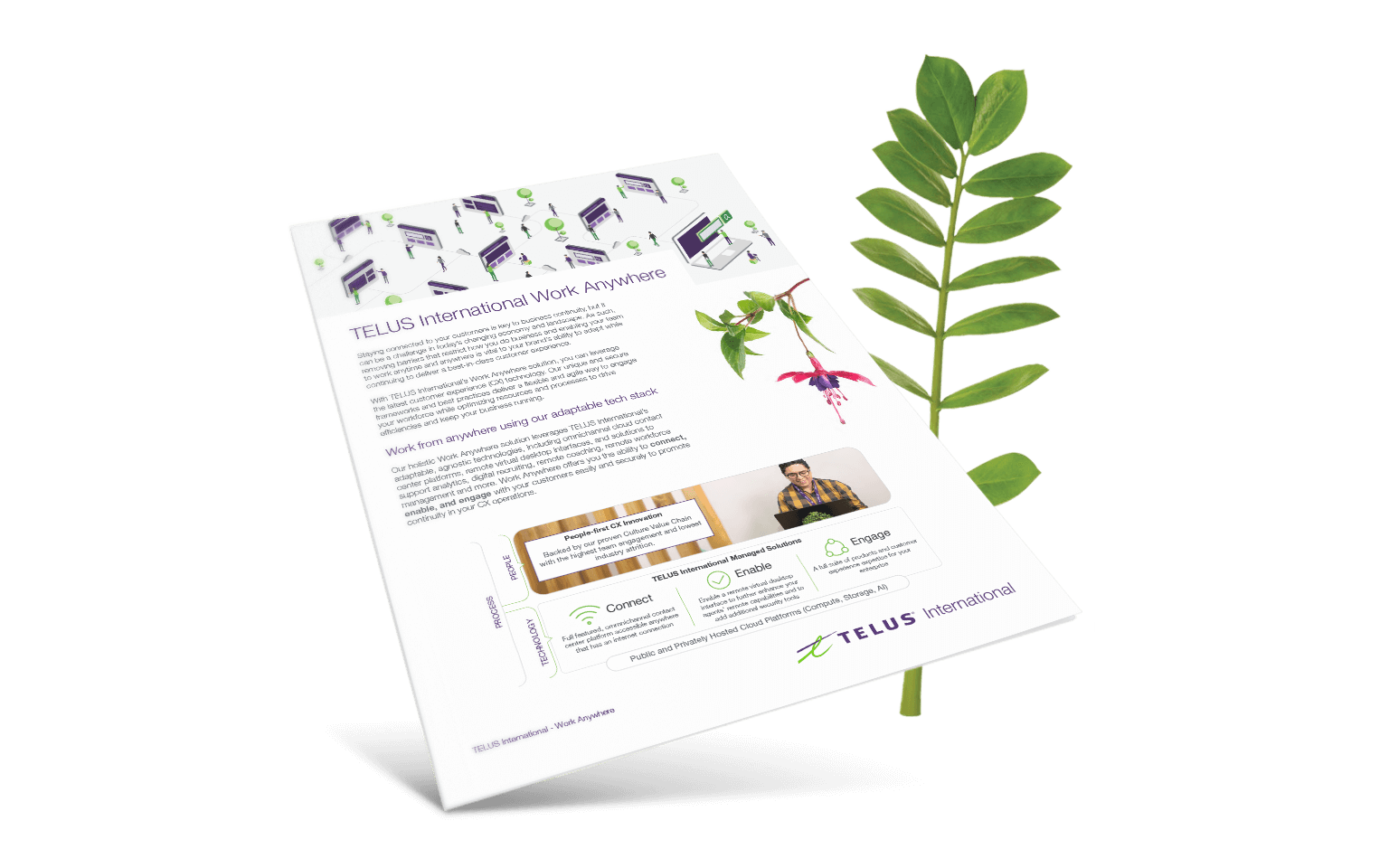- Insights
- People & Culture
- Article
What's the surprising key to long-term remote working productivity?

In the early days of the COVID-19 pandemic, many employers were surprised by the productivity increases they saw from their teams when they made the shift to remote work. But there’s evidence to suggest that those initial increases may have been temporary in nature.
Now, with the world opening back up, companies are debating the right time to return to an office environment ‒ if at all. A recent survey of technology leaders by TELUS International revealed that only 17% anticipate being back in the office full-time within the next six months.

While the ‘new normal’ continues to evolve, companies must have a strategy to stay ahead of long-term employee burnout. This includes investing in corporate culture and communication, cultivating compassion in their leaders, and encouraging and supporting self-care in workers.
Techniques to help remote teams avoid burnout
Addressing long-term burnout begins with understanding the different circumstances that individuals may be facing while working from home. “The remote environment likely contains more distractions and less oversight,” says professor Glenn Dutcher, economics professor at Ohio University, who studies the effects of work environments. When working from home, it’s harder to concentrate on mechanical activities like filing reports, as a repetitive job can quickly become a stressful one. Alternately, workers tend to focus better on creative tasks than they do on mundane ones when working remotely, he says.
In addition to daily work-related stress, some team members may also be saddled with navigating the complexities of childcare in an at-home environment. Many people may have difficulty finding a quiet space to work, or they may just simply miss their in-person work environments.
To address the void that many are feeling, TELUS International research suggests that culture-building activities that help employees connect and continue to develop themselves are critical. To build culture in a remote work environment, 68% of employees want virtual workshops and continued learning opportunities. Continued weekly staff meetings and one-on-ones with managers are important to 66% of respondents, and schedule flexibility remains a priority for 65% of people.
Two-way communication can help team members and organizations better cope with pandemic-related changes. For instance, some companies circulate small, informal surveys to gauge changes in employee sentiment and seek real-time employee feedback. Based on those survey results, HR teams may offer ongoing guidance on self-care, safety and health resources.
How to build compassion in leaders and employees
Training, development and communication programs can help stave off employee burnout by helping team members stay engaged and making them feel cared for.
Still, nearly everyone is experiencing challenges and hardships that a positive attitude simply can’t fix. That’s why an increasing number of workplace culture experts suggest developing another important skill: compassion — toward ourselves and toward our friends, relatives and colleagues.
For a long time, the idea of developing compassion was relegated to self-help books and religious texts. Now, compassion has found its way into business schools as a way to infuse a more caring culture into organizations.
“We cultivate compassion by creating in ourselves and in our teams and organizations the capacity for noticing suffering, interpreting suffering generously, feeling empathetic concern and acting to alleviate the suffering,” says Jane Dutton, University of Michigan professor and co-author of Awakening Compassion at Work.
Other than simply noticing suffering, Dutton says it’s important to create safe spaces, or safe times, for people to share their experiences and challenges. She says it’s particularly important for leaders to model compassionate behavior by disclosing their own sources of pain, anxiety, fear and loss. This activity helps foster “empathetic concern,” where individuals put themselves in other peoples’ shoes and try to authentically understand their experiences.
How compassionate teams will face the new normal
It’s nearly impossible to understand someone else’s experience — or feel compassion for them — without communication.
Dutcher studies teamwork across a variety of circumstances, and he says people often believe remote workers don’t work as hard, an idea that can breed contempt among colleagues. He says tackling this head on requires consistent communication —not only about the stresses they are facing, but also about the specific contributions they’re making to the overall team’s work. These missives shouldn’t only come from employees; people in managerial and senior positions should also openly communicate this information.
Understanding someone else’s experience and showing empathy is a skill that transcends the pandemic. Leaders that acknowledge suffering and offer simple kindness to team members create better relationships, decrease burnout and may even help their teams perform better, says Dutton.
For example, sending notes of encouragement that acknowledge that things are difficult or hard to bear can make a huge difference to people struggling at home or at work. “Remember that actions do not have to be big to be healing to others,” says Dutton.
As compassionate interactions become commonplace and part of your company’s DNA, you will create a more positive cultural environment where employees can thrive and even innovate to deliver differentiated customer service—despite challenging external circumstances. Combined with conscious culture-building activities and meaningful learning opportunities, compassion may hold the key to sustained productivity and better performance regardless of workplace environment.



